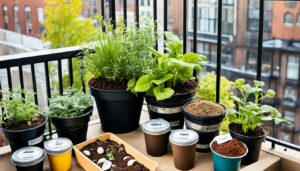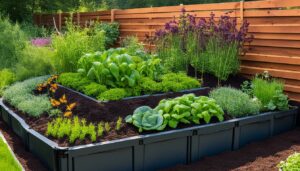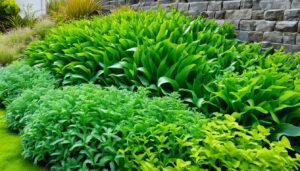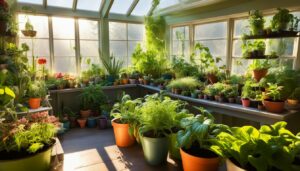There is a touch of magic that arises in the universe of gardening when we become stewards of the land, nurturing the soil with Companion Planting — a harmonious dialogue whispered among roots and leaves. It is a canvas painted with diversity, where each plant contributes to a collective symphony of growth, scent, and succulence. As we immerse our hands in the earth, we celebrate a resurgence of natural gardening techniques honed by generations before us. Our gardens burgeon, not just in yield but in spirit, epitomizing sustainable gardening and eco-friendly gardening practices.
In the intricate dance of foliage, flowers, and burgeoning fruits, we find nature’s secrets to maximizing garden yield. By tenderly weaving together different species, we unlock plant synergies—those silent, enigmatic forces that discourage pests, enhance soil fertility, and bolster the immunity of our precious seedlings. Behold the power of companion planting tips to foster a thriving garden. This practice, embraced by Earth’s ancient wisdom, is an enduring testament to fostering garden productivity and diminish the reliance on natural pesticides. Let us journey together through the lush verdure of knowledge, discovering techniques to elevate our gardens into oasis of abundance.
Key Takeaways
- Discover the art of companion planting to naturally increase your garden’s resilience and productivity.
- Implement eco-friendly gardening practices to foster a sustainable and thriving ecosystem in your backyard.
- Learn how smart plant pairings using companion planting tips can serve as natural pesticides.
- Maximize garden yield by understanding and harnessing plant synergies.
- Embrace the wisdom of ancient techniques to enhance garden productivity through natural processes.
- Boost your garden’s health and vibrancy with strategic, sustainable gardening methods.
Embracing Square Foot Gardening and Companion Planting
Revolutionizing what it means to cultivate a vegetable garden, Square Foot Gardening answers the call of Space Maximization in the realm of Urban Gardening and Small-Space Gardening. This technique is not only a boon for efficient gardening methods but a true artisan of the beautiful gardens we covet. But what elevates this method to new heights is the incorporation of Companion Planting Synergy, a practice that ensures a Sustainable Plant Growth and a harmonious garden ecosystem teeming with life and color.
Defining Square Foot Gardening and Its Advantages
In the bustling cityscapes and cozy backyards, Container Gardening and Raised Garden Beds are reshaping our perspectives on gardening. Square Foot Gardening epitomizes these changes by dividing a growing area into a grid of square feet, each hosting a different plant or crop. This ecosystem of raised beds ensures optimal utilization of space while also allowing for easier management, be it in watering practices or pain-staking weeding endeavors—quite a delightful endeavor for every urban gardener seeking Vegetable Garden Harmony.
The Synergy of Companion Planting in Square Foot Gardens
Delve into the world of Companion Planting where plant relationships foster a network of Pest Control and Soil Enrichment. In the condensed framework of Square Foot Gardens, companion planting exploits every inch of soil, inviting beneficial interactions that result in robust crop improvement. Have beans that fix nitrogen in the soil? Place them beside your hungry corn stalks and observe the tangible improvement in their growth, manifesting the virtues of Nitrogen-Fixing Plants and intense gardening practices that yield a sustainable harvest without forsaking square footage.
Boosting Aroma and Color with Thoughtful Plant Combinations
The art of Square Foot and Companion Planting transcends practical benefits; it’s also about crafting an Aromatic Garden that appeals to the senses. Through strategic planting combinations, one can witness a Colorful Garden Landscape coming to life. Marigolds shimmer in the sun, adding splashes of gold and orange, while rosemary and basil exude scents that attract pollinators. The splendor of an Aromatic Garden lies in such thoughtful plant aesthetics, which bring more than visual appeal—they offer a complete Sensory Gardening Experience. This blend of Herbal Companions maximizes your garden’s potential, transforming it into a resilient and beautiful garden that is as delightful to the senses as it is to the table.
As we consider the intersection of functionality and beauty in our gardens, Square Foot Gardening and Companion Planting stand as beacons of efficiency and environmental consciousness, portraying a symbiotic relationship between urban living and the age-old tradition of tending the earth—a continuous quest for a sustainable, space-efficient slice of paradise.
Unlocking the Benefits of Companion Planting
Embracing companion planting is akin to discovering a treasure trove of gardening wisdom. Not only does it contribute to visually appealing landscapes, but the benefits of these ecological gardening methods are extensive and sustainable. Healthy gardens thrive under the influence of companion planting, thanks to its multifaceted approach to natural pest management, soil health, and biodiversity.
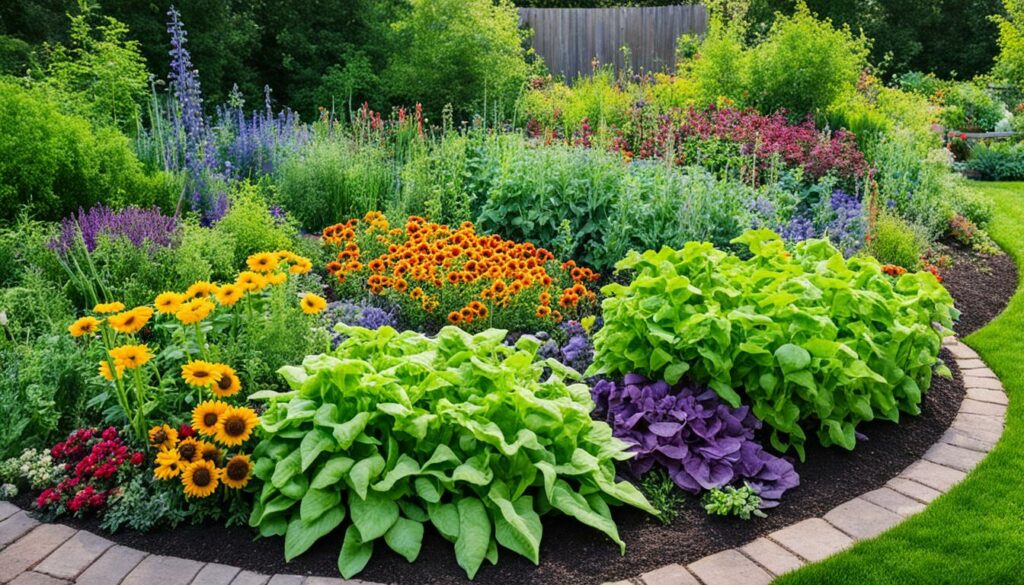
Soil quality improvement arises naturally when strategic plant pairings enrich the earth with essential nutrients. Take, for instance, the symbiotic relationship between legumes and virtually any other plant in the garden. Legumes possess the natural ability to fix nitrogen in the soil, thus creating a more fertile ground for their companions.
The art of companion planting extends its advantages to managing pests without resorting to chemical pesticides. By leveraging the complex aromas of certain plants, gardeners can confuse and repel pests, safeguarding their crops while maintaining an eco-friendly sanctuary. Imagine the simple act of planting strong-scented herbs amidst your vegetables; this small step can yield significant rewards in shielding your produce from unwelcome insects.
- Pollinator attraction: Flowers and flowering herbs integrated into the garden matrix act as beacons for bees, butterflies, and other pollinators. Their presence is instrumental for successful fruit and seed production.
- Garden space optimization: By understanding the spatial requirements of plants, gardeners can elegantly design their plots, pairing deep and shallow-rooted varieties to fully utilize available space.
All of these companion planting advantages culminate in a holistic approach that emphasizes the importance of natural balance and biodiversity in our gardens. Cultivating a patchwork of mutually beneficial plants not only enhances the resilience of your garden ecosystem but also contributes to the overall health of the environment we share.
Companion Planting Guide: Maximizing Garden Health
Embarking on the journey of creating a flourishing garden ecosystem requires a keen understanding of plant relationships and strategic garden design. Companion planting stands as a pillar in achieving a harmonious interplay between flora, ensuring garden optimization and a bountiful harvest. With a wealth of companion planting resources at our disposal, let’s dive into the intricacies of efficient plant pairings and the development of a customized companion planting chart to guide our green thumbs.
Essential Companion Planting Pairings
The backbone of any resourceful garden planning is an understanding of plant compatibility. Certain plant pairings are tremendously effective in cultivating garden ecosystem balance. For instance, planting marigolds alongside your vegetables serves as a natural pest deterrent, while allowing crops like beans to coexist with corn assists in beneficial insect attractions due to their shared affinity for a common garden predator. The right efficient plant pairings create a network of support, where each species works to the collective benefit of the community.
Creating Your Companion Planting Chart for Easy Reference
The personalized companion planting chart is not merely a garden planning tool but your ally in achieving companion planting success. Through the careful selection of plant pairings, your chart becomes the roadmap to garden layout optimization. Consider including a blend of pest deterrent plants and those that attract pollinators to achieve a garden layout that’s both beautiful and functional. This level of strategic garden design underscores the value of custom gardening guides.
Aligning Your Garden Layout with Companion Planting Guidelines
Garden mapping with a plant placement strategy ensures you place the right plant in the right place, fostering a thriving garden. With consideration for garden optimization and plant-specific needs such as light, water, and nutrient requirements, you forge a strategic garden design that not only looks great but is also primed for garden layout optimization. Below, a chart delineates some ideal companion plantings, providing you with a model for your garden planning.
| Companion Plant | Benefits |
|---|---|
| Tomatoes & Basil | Enhances flavor, repels pests |
| Carrots & Onions | Pest control, maximizes space |
| Beans & Corn | Nitrogen fixer, stalk support for climbing beans |
| Cucumbers & Nasturtiums | Repels cucumber beetles, improves growth and flavor |
| Lettuce & Chives | Chives deter aphids, while lettuce provides ground shade |
By integrating these essential concepts and leveraging companion planting resources, your garden is set to be not only a source of pride but also a testament to effective garden ecosystem management.
Innovative Strategies for Companion Planting Vegetables and Herbs
Modern gardens brim with potential when traditional wisdom meets innovative techniques, particularly in the practice of companion planting. Exploring methods such as interplanting, relay planting, and succession planting alongside ecological principles elevates the art of gardening to new heights. The essence of this approach is to foster plant growth efficiency, achieve a continuous harvest, and enhance soil utilization—while nurturing an environment that attracts pollinators and beneficial predators to maintain a natural garden defense.
Interplanting Techniques for Vegetable Garden Efficiency
In the art of interplanting, vegetables and herbs are interwoven in the same plots, enabling a mixed cropping environment where plant diversity reigns. This practice is rooted in intensive gardening practices, allowing plants with different maturation times, such as rapid maturation crops, to coexist harmoniously. Lettuce can be harvested while slower-growing carrots have yet to mature, exemplifying savvy space and soil utilization. Interplanting ensures high garden productivity and a vibrant companion planting ecosystem right in your backyard.
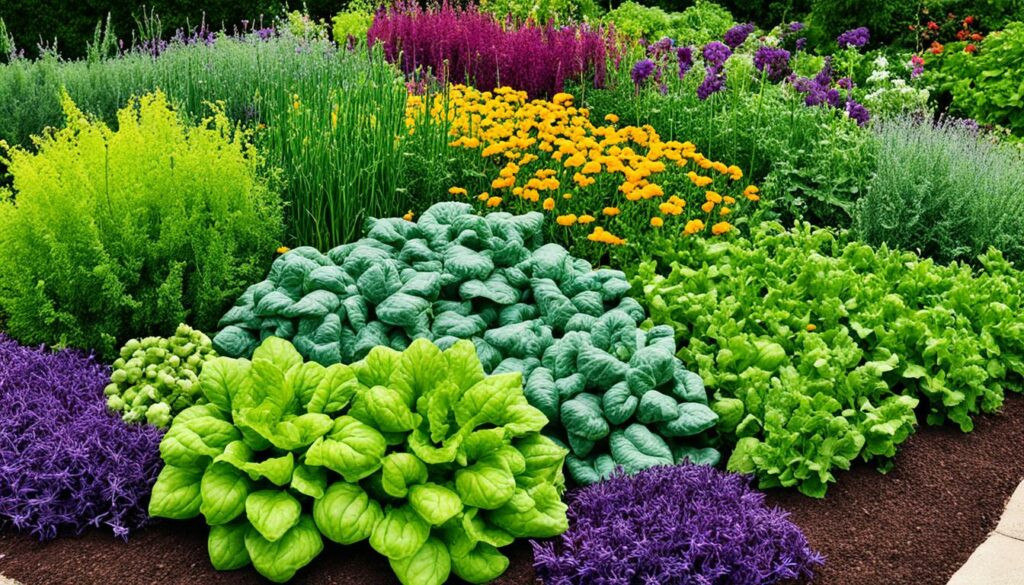
Relay and Succession Planting: Timing for Continuous Harvest
A gardener’s dream of a prolonged vegetable supply becomes reality through the strategic use of relay planting and succession planting. The key is timing, where crops are planted in waves; as one is harvested, another takes its place. This technique, a staple in seasonal gardening techniques, ensures a continuous harvest and a cornucopia of fresh produce throughout the season. Integrate a crop rotation strategy for added benefits, including reduced soil depletion and the interruption of pest and disease cycles.
The Role of Companion Planting in Attracting Pollinators and Predators
The meticulous arrangement of vegetables and herbs does more than optimize space; it’s a clarion call for attracting pollinators and beneficial predators that serve as a natural defense for your garden. Incorporating a pollinator-friendly garden design is a cornerstone of environmental stewardship, promoting garden biodiversity and establishing an ecological balance. By intermingling nectar-rich flowers and fragrant herbs among your vegetables, you encourage a thriving, self-regulating companion planting ecosystem, where the garden’s beauty matches its productivity.
Conclusion
The journey through the art of companion planting reaches a profound conclusion, reflecting a tapestry of green wisdom. This gardening practice encapsulates more than just the promise of a **sustainable harvest**; it embodies a tradition enriched with innovation and a commitment to **eco-conscious gardening methods**. Gardeners who embrace these natural gardening solutions find themselves at the forefront of a movement—cultivating not only vegetables and herbs but a vibrant, dynamic ecosystem.
In the folds of each garden, there is a story of **companion planting success**, shared with and celebrated by the wider **gardening community**. By incorporating these practices, enthusiasts of all skill levels contribute their verse to this growing narrative, reaping both personal satisfaction and the rewards of a thriving garden. The exchange of **gardening insights** propels us forward, ensuring that knowledge continues to blossom alongside the fruits of our labor.
The alchemy of nurturing the earth and witnessing the lush fruition of that care bestows upon us a sense of fulfillment that transcends the soil. It’s not just about the harvest on the table, but also the shared **gardening satisfaction** and the ripple effect of our **eco-conscious choices**. Our collective efforts to deploy natural techniques for a **sustainable harvest** hint at a greener, more harmonious future—tangible proof that when we sow with intention, nature rewards us with abundance.



